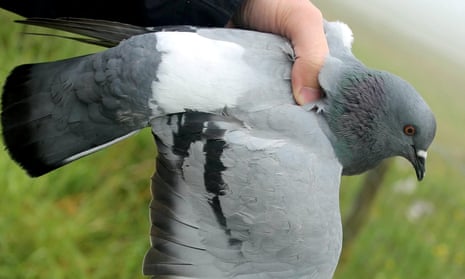Colonies of extremely rare and endangered birds that are the wild ancestors of domestic and feral pigeons have been found on secluded Scottish islands.
Researchers have spoken of their excitement and surprise at discovering small populations of wild rock doves in places that include the Outer Hebrides.
It is thought rock doves were domesticated, originally to provide food, between 5,000 and 10,000 years ago making them some of the first domesticated birds.
Feral pigeons originate from escaped domestic birds and can be seen in towns and cities everywhere. As feral pigeons thrived, rock doves – partly because of extensive interbreeding – declined around the world.
Will Smith, an Oxford University DPhil student and lead author of a new study, said there had been lots of research into Scottish wildcats and how hybridisation with feral cats had pushed the species to the brink of extinction. But there was hardly any into rock doves and their similar trajectory because of feral pigeons.
“If you ask most bird watchers in the UK about rock doves they will say they’ve been hybridised out of existence by feral pigeons,” he said.
The Oxford research team identified relict populations of rock doves and then set about analysing their DNA to determine whether the birds were truly “wild”.
“This is the first genomic study that proves there are undomesticated rock doves that are relatively isolated from feral pigeons,” said Smith. “It was quite a surprise. It is exciting. It is also kind of weird that it’s in the UK because there are so many feral pigeons here. I guess places like the Outer Hebrides are far enough away from from towns and cities that there’s less gene flow.”
To the untrained eye, rock doves look similar to pigeons. The biggest difference is that if you see a flock of pigeons there will be many different colours whereas rock doves are identical with the same plumage.
“The rock dove is like a wolf,” said Smith, “in that all wolves kind of look the same colour-wise, whereas feral pigeons are like dogs and all look different.”
The Scottish rock doves live in sea caves and ruins. To see flocks of them flying from their nests to feed in flower meadows is, said Smith, a “really lovely experience … to see that happening every morning and every night, flying back and forwards.
“It is the sort of movement that is less obvious in feral pigeons because they might move from one street to a different street, or from McDonald’s to Waitrose.”
The research team managed to confirm that its rock doves were descended from the undomesticated lineage from which all feral pigeons originate.
Some of the rock doves the team examined in Orkney had experienced extensive interbreeding with pigeons. But the Outer Hebridean rock doves showed “negligible signs of hybridisation”, said Smith.
The team hopes the conclusions, published in the journal iScience, will encourage research into potential wild rock dove populations in other parts of the world.
Also increasing understanding of “extinction by hybridisation” will, said Smith, help efforts to prevent other plants and animals undergoing the same fate as the rock dove.
